Autodesk® Architectural Desktop, Release 3 Service Pack 1 (English Locked)

In our first review on ADT 3.0 we looked over the surface of the product with some minor investigations into the deeper realm of a few specific areas. This time we'll look at a broader summation and more in-depth specifics.
The image to the right was derived from my frustration with the standard run-of-the-mill ADT 3.0 reviews that have been popping up all over the place. Ratings seem so arbitrary unless they come from actual scientific comparisons and who can measure logical systems with calipers anyway. Instead, I propose this graphic image and hope that my architectural minded colleagues can derive more meaning from it than arbitrary numbers.
Personally, what I see in ADT 3.0 is what I have attempted to illustrate to the right: a shell around an AutoCAD core with a hap-hazard array of modules that have various degrees of connection to the core and each other.
This probably sounds like a really harsh description but that's what it feels like when working with this product. As a user, I have a sensation of independent development teams working away to solve their respective assignments while leaving cohesion to yet another team.
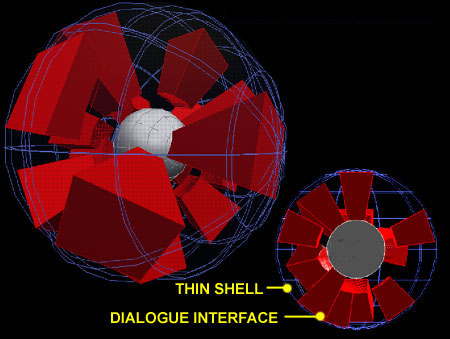
Listening to architects and designers, even savvy AutoCAD users, discuss the convoluted nature of this tool confirms my belief that it will have to be redesigned. I am honestly impressed by its capabilities and believe that I can, in part, comprehend the difficulty of developing a tool to handle such a dynamic problem as a Curtain Wall, but I can also see how many will not be able to master it.
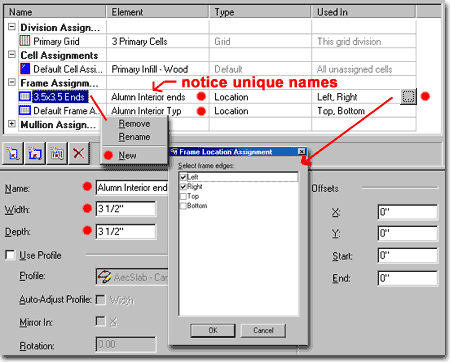
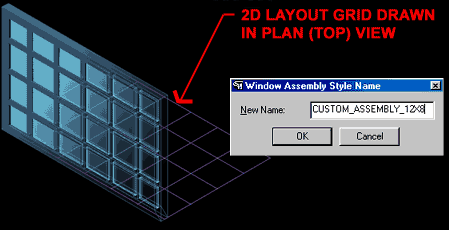
My advice to Autodesk is to use a similar system to break up the Curtain Wall and Window Assembly components. Maybe call one tab "Body", another "Panels" and the next one "Mullions". Using graphics on each tab, similar to the one used for Muntins, the user should be able to see what area of a their design they are working on (the model explorer tool is good but having it integrated is better). And for those users who can't stand dialogue boxes, more work should be put into the "Edit in Place" with Cell Markers concept. Ideally a user should be able to solve the same set of design problems going at numerically or graphically.
I think the basic pieces are actually all there but they just need refinement.
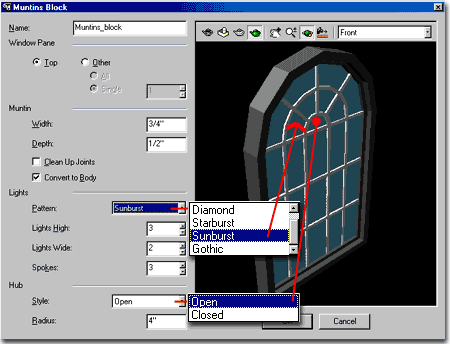
In other words, as a user, I would really like to be able to use the Trim and Extend commands throughout ADT and not have to switch to another Trim and Extend command set in order to work with Slabs, Roof Slabs and Walls. Running multiple Layer Managers is also proving to be rather irritating; the two versions should just be merged and regular AutoCAD users could benefit greatly from some of the neat features found in the ADT Layer Manager; like Layer Grouping. The Drawing Setup features compete with the Units command and should also just be merged. For more years than I can count now, my students have been aching for a drawing scale option that just sets all units appropriately so they don't have to struggle with default Dim Styles, Text Styles and Linetypes.
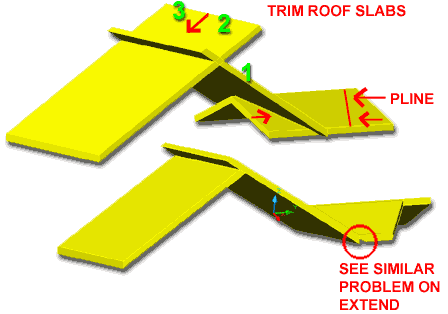
From the previous
review:
To anyone who has been working with ADT 1.0 and 2.0,
this release should feel like some one listened to your complaints. The focus of this
upgrade seems to be on the Design commands and the Display
system with little to no changes in the Massing and Layering commands. There are
also many new features that deserve praise such as the structural tools, slab tools and
International Extensions.
To the right, I show just a few of the new possibilities: a steel library, z-axis Wall profiling, Slab roofs with edge and soffit types, totally wild Spline tracing Curtain Walls, Pline Extending Stairs and more flexible handrails.
Throughout this upgrade, there are numerous hints at the future of this program with buttons directing you to Autodesk's Point A website and new integration of XML for structural element specification. Though I am very interested in the possibilities of using the Internet as part of CAD design, I find myself questioning the fruition of such integration at this time; especially when most of the links to Point A lead to empty spaces ala the infamous "under construction" pages of many early websites with grandiose plans. You can now, for example, link to Point A when looking for Door and Window styles, but you won't find much. I checked for many different styles and in a lot of cases found nothing offered. In addition, it appears that Autodesk is only allowing free access for a limited time with intentions to charge or make it part of their VIP program - see image below.
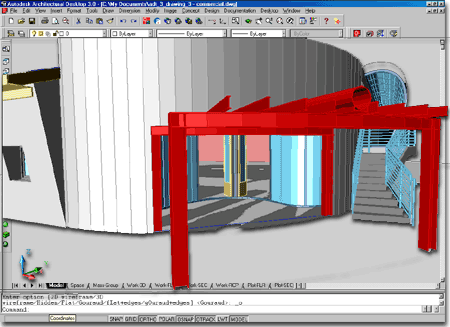
I just checked Point A with my Style Manager (04/01/01) and there are still no interesting offerings. I am sure those of you who have already begun using ADT 3.0 have found the need for more Styles. Personally, I think the Point A concept would be far more valuable if there was an incentive for users to contribute directly to it with their time consuming Style Designs - how about a two-way drag-n-drop? Okay, who's going to check for design accuracy...just a thought.
ADT 3.0's list of new and expanded toolbars say a lot about what you can expect from this upgrade; it is both an expansion of ADT 2.0i and improvement. If you take a look at the Roofs toolbar, for example, you will notice it is now called Roofs - Roof Slabs and there is an accompanying Roof Slabs Tools toolbar. As you might guess from the toolbars and buttons, the previous Roof routines remain with an addition of a whole new suite of Roof routines called Roof Slabs.
See our latest article on condensing this huge set of toolbars - Smarter Menus for ADT 3.0
Unfortunately, as you might also guess, the solution to one routine's failures seems to be a new set of tools. To make the transition between the two routines, there is a Convert to Slab routine that is basically an advanced form of taking a Roof object and converting it into a Mass Element; well, let's call it a smart Roof Mass Element. Don't get me wrong, I am impressed with the Slab concept but I am also disappointed that the original Roof object wasn't simply developed into a "smarter" object that would behave much like Walls. Perhaps in the next release, they will do away with the old Roof object and simply have a Roof Slab routine that does it all; that would be my preference.


An example of ADT 3.0's new structure is the Style Manager; a Window that serves as a central tool for managing all Object Styles. You can now quickly create, load, modify and even download various object styles all as part of one task within this tool.
Illustrated to the right is one of the few object styles that has one downloadable sample on Autodesk's Point A website. If this feature truly takes off and has energy put behind it, having an on-line library of Styles could be a huge time saving option. I would also like to see similar efforts made towards a Design Content library.
I recently revisited Point A ( 03/08/01 ) and there's nothing there to get excited about. I also noticed this time that I can't aim my Style Manager to any other internet sites, like ARCHIdigm.com where I might actually be able to take advantage of more i-drop styles. I guess it's early yet to hope for cool stuff so I'll check back next year.
If you are in desire of going to a website ( or creating one ) for styles, you can use the Open folder and browse for .dwg files at any URL. It works rather well actually and once you select a .dwg, the Style Manager sees it as if you opened it off your local drive.
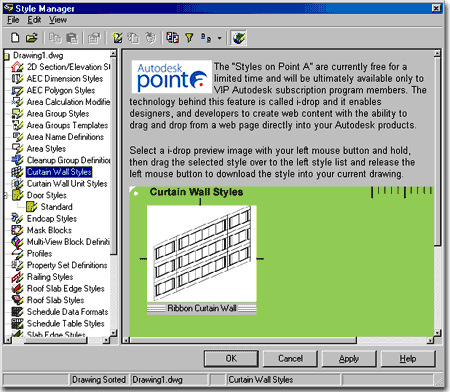
If you tried working with the Display system of ADT 1.0 and 2.0, you should find the new interface a pleasant surprise. The logic and structure of display representations has not changed but how you manage it is what this window makes easier to comprehend. The main improvement, as illustrated to the right, is in a graphical column and row layout so you can more easily correlate the three facets of Display: Object Appearance, Appearance Set and Set Orientation - these are, of course, my terms for what goes on inside ADT.
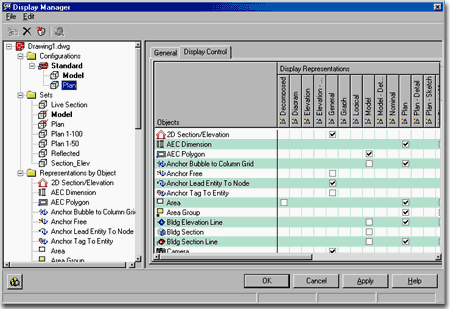
Illustrated to the right is what you get when you open any older format files; just a friendly reminder about backwards "incompatibility".
You can use the AECFILESAVEMESSAGE variable to deactivate this dialogue warning if it begins to annoy you; particularly useful for scripts too.
ADT 3.0 does not offer any new Save As... options over AutoCAD 2000; i.e., it's the same Save As... list. You can save in 2000, R14, R13 and various other DXF formats.
So far, the only problems I have found with my ADT 2.0i files in ADT 3.0 have to do with Stairs. For some reason, many of my Stairs have developed the dreaded red-circle-of-death and the fix has not been easy. I have found that if you uncheck the Use Rule Based Calculator option for these Stair Styles, the problems are solved. I have also had problems with Wall Cleanup issues that were fixed by adjusting Cleanup Radius settings and/or using different Cleanup Groups. There have also been other strange Schedule problems because of the new object definitions in ADT 3.0 that I have yet to resolve.
Just recently I attempted to resolve some of my Stair issues only to discover that the ADT 3.0 Help menu and Documentation has a significant error on page 404 regarding Stair options - the story from Autodesk is that this is a feature that did not make it into the final release but will come in the future - hmmm! I'd like to pull that tactic at the Building Department when they reject my plans.
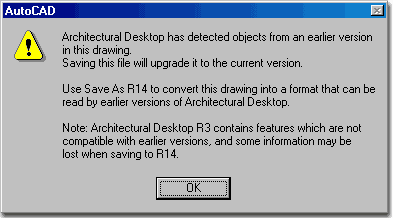
As for working on ADT 3.0 files in ADT 2.0, I have run some tests and am finding rather startling results.
Rumor has it that many or all of ADT 3.0's Objects were redefined, even the basic Wall Object and with no SAVE AS...R2 option, backwards compatibility is quite weak.
Here's what I have discovered so far: (note: these are basic personal tests and may not be conclusive. These tests were also not performed with any Object Enablers - see comments below).
Message you get in ADT 2.0 Opening an ADT 3.0 file Saved As...2000
Opening an AutoCAD 2000 format file.
Regenerating model.
ARX_ERROR: eNotThatKindOfClass
ARX_ERROR: eNotThatKindOfClass
ARX_ERROR: eNotThatKindOfClass
ARX_ERROR: eNotThatKindOfClass
.
.
If you Save As...R14, the outcome is better but rather disappointing. Walls, Doors and Window type Objects, the basic set from ADT 1.0, come through as native Objects but with problems. If you use a new feature of ADT 3.0, like Wall Profile, and send it back to R14, the Wall Object reverts to a normal non-profiled Wall, which in turn may now develop other problems; like Wall Cleanup issues. In fact, in some of my tests, I have noticed numerous red-circles-of-death on Walls. Other obvious problems occur with new ADT 3.0 Objects that didn't exist in the ADT 1.0 version; like Slabs, Curtain Walls, Steel Columns and Beams, etc; e.g. they become proxies.
As for "round-tripping", I am also a bit surprised with my tests so far on this subject. ADT 2.0 seemed rather successful at holding on to information saved in R14 format when re-opened. I took some ADT 3.0 files and saved them in R14 format, loaded them in ADT 2.0 where I saved them again and re-opened them in ADT 3.0. All of the objects, even those that were Proxies in ADT 2.0 came through okay, but those objects that got changed in ADT 2.0 came back as ADT 2.0 styles. In other words, that cool Stair modification and Wall Profile, for example, was lost in the round-trip.
![]() I honestly don't know if I can say that the story is getting better or
worse. If you visit the Autodesk Object Enabler website and read up on the OE
choices you will probably get a headache. As I understand it, the new Arch 3.02 OE
is for ADT 2.0i ( not ADT 2.0 ), must be installed after the 2.0 OE has been uninstalled
and creates a new ADT 2.0i icon for launching ADT 2.0i. Using this icon
will allow ADT 2.0i to work with ADT 3.0 objects but will also save back in ADT 3.0
format.
I honestly don't know if I can say that the story is getting better or
worse. If you visit the Autodesk Object Enabler website and read up on the OE
choices you will probably get a headache. As I understand it, the new Arch 3.02 OE
is for ADT 2.0i ( not ADT 2.0 ), must be installed after the 2.0 OE has been uninstalled
and creates a new ADT 2.0i icon for launching ADT 2.0i. Using this icon
will allow ADT 2.0i to work with ADT 3.0 objects but will also save back in ADT 3.0
format.
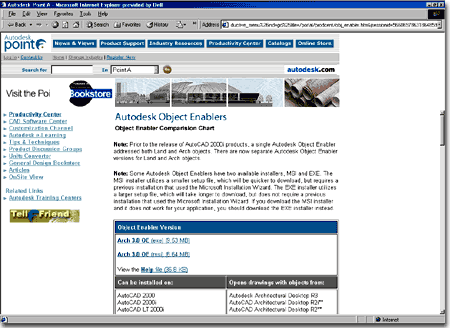
My tests confirm that the Arch 3.02 OE works and I was happy to see no Proxy Warnings when opening ADT 3.0 files in ADT 2.0i. My recommendation though, is to not mess around with both versions, just convert or stay with ADT 2.0i if you can. Also, my installation of the ARCH 3.02 OE installed the "oeLaunch.exe" file in my ADT 3.0 folder instead of where it should have gone; in the ADT 2.0i folder ( where I manually moved it to). Another thing that went wrong for me, was that when I followed the instructions to uninstall the 2.0 OE files, I blew out all of the associated files needed to make the regular ADT 2.0i objects work.
But wait, the OE story gets more interesting. If you want to work in ADT 3.0 and not convert ADT 2.0i objects into ADT 3.0 objects, you can download the Arch 2.53 OE for ADT 3.0. Using this Object Enabler will allow ADT 3.0 users to keep ADT 2.0i objects from getting "polluted", but then what's the point of using ADT 3.0
Using the Arch 3.02 OE allows ADT 2.0i users to work with ADT 3.0 objects and thats about as far as it goes. If you want to go back farther, like ADT 2.0, it's a crap shoot on object translation and you may be better off Saving As... AutoCAD R14 but then you may loose important information like unique Wall Profiles.
In our office, we've given up on attempting to work in round-trip mode; if ADT 3.0 files need to go back, we treat them like one-way tickets. For drawing information that needs to be added on top of our ADT 3.0 files, we Xref it in while others work on Xref's of our down-verted ADT 3.0 files.
Autodesk announced on their website, what feels like ages ago, that they were no longer going to offer the Express Tools in the form that many users have grown accustomed to nor as a free download. If you were diligent about downloading every free release, the last one was called "etv1-9.exe", but there was an even more current version available on Autodesk's beta site ( I forget it's name ). For those of us who have been with this "game" for enough years, we have seen the Bonus tools come and go and the super special VIP Express Tools simply become available to everyone at no additional cost so we'll see what happens next. As I understand it, the new "game" is to get us to become VIP members once again and get super special .ARX applications instead. These .ARX ( and other format ) applications are also available by individual purchase and are currently called "AutoCAD Extensions" Here's where they were listed the last time I checked -> Autodesk - AutoCAD - Extensions
As for the missing Express Tools and your installation of ADT 3.0, you can manually migrate them from any other AutoCAD or ADT installation that has them installed and running correctly. Here's how.
1 ) Copy the entire Express folder from your ADT 2.0 or AutoCAD 2000 ( or other ) to your Architectural Desktop 3 folder; i.e., you are creating a new Express folder for ADT 3.0 with all of the same files.
2 ) Now you have to copy the other odd files from their respective folders to the same folders inside ADT 3.0:
support\acettest.fas |
|
help\acetmain.hlp |
These are only the help files so if you don't have them it is not a big deal. There are also two other files: acet.chm and acet.lim that should already be in your ADT 3.0 help folder. You can copy all acet* files to make sure you get all of the help stuff or ignore them. |
help\acetmain.cnt |
|
help\acetfaq.hlp |
3 ) Load or Reload ADT 3.0 and type ExpressMenu in ADT 3.0 and load the Express Tools. You should need to "Perform a full rebuilt...", but it won't hurt to do it unless you have have customized it.
If you are an IT or CAD manager running this through an office network, you may need to use Menuload to get the pathing right. But remember that you'll need to set the paths on the Options dialogue box too.
To be perfectly frank, as soon as I saw two CD's in my ADT 3.0 package ( one for ADT 2.0i, which I already have and the other for ADT 3.0 ), I ran through my ADT 2.0i folders and copied everything that I had customized to temporary folders and Uninstalled ADT 2.0i. It's not that I don't believe Autodesk has written a fine migration routine as much as my experience with botched migrations that made me opt out this time. The ADT 2.0 to ADT 2.0 i migration was one of the smoothest migrations I have experience with AutoCAD but since I had a patch crash on ADT 2.0i, it has run very poorly despite my efforts at fixing it. Combining all of this, I simply decided to do a clean install and it has run without a glitch.
I do not recommend my process unless you are certain of what you are doing; i.e, manually capturing and restoring customizations including the Express Tools, which are no longer part of the package. See above to find out more about the Express Tools.
That is just my lengthy explanation of why I don't have the Migration dialogue boxes captured at this time. The installation dialogue box to the right, and below come from a fresh new install.
If you use both Imperial and Metric Format, pick the more prevalent and simply add the other on the Custom dialogue box ( see below right ).
I recommend installing the International Extensions even if you work in Imperial Format because there are some very cool routines there, like Area calculation tools.
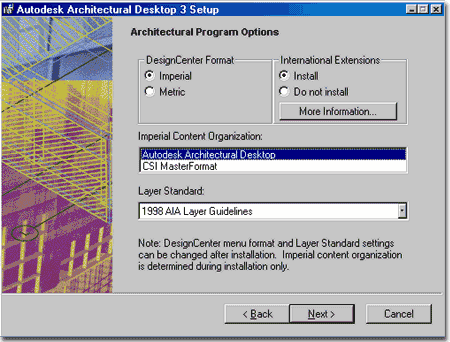
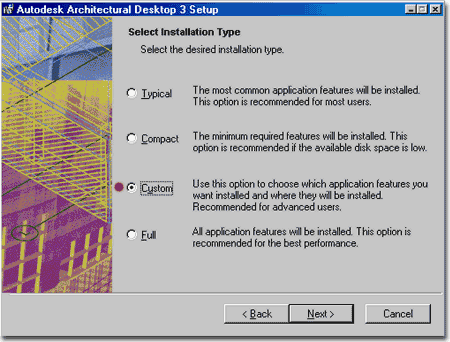
Here are some unexpected improvements; just pick on any hard-drive icon with a down arrow and decide how you want the installation on the pop-up menu ( illustrated right ). Notice that you can now add Metric or Imperial if you want everything, like me ( it'll cost you about a half gig though ).
And that's it for a fresh installation. When I have the time to practice a Migration, I will post that information if necessary.

Depending upon the power of your computer, you may notice a performance degradation when you first load ADT 3.0. It really isn't a degradation but rather a difference in how ADT loads. If you take a look at the properties of your ADT 3.0 Desktop Icon, you should discover that ADT 3.0 now loads with the Aec Arch (Imperial - Intl).dwt instead of the long lived traditional acad.dwt template file. What this does, is load all of the ADT components right away preventing a lag when you begin drawing your first ADT object. Since I don't always draw ADT stuff in ADT, I set my startup icon to use my own simple non-ADT template file. This makes loading occur a lot faster but I do pay for it when I want to draw my first ADT object.
If you did not upgrade to ADT 2.0i, you may also find the new html start-up dialogue box, called Today, a bit slower than what you are accustomed to. It's a cool tool but it does slow my system down so I turn it off - you can read about how to do that on our ADT 2.0i review.
Model Year 2000, Dell Inspiron 7500. 500Mhz PIII. 15.4 inch display. 8Mb SGram Rage Mobility Video. 18Gig IDE H.D. 256 Mb, 100Mhz Ram. Floppy/CD/DVD combo - bay #1 and Battery or Zip drive - bay #2. Windows '98 2nd Edition for OS.